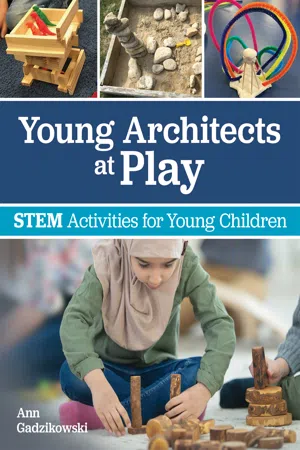
- English
- ePUB (mobile friendly)
- Available on iOS & Android
eBook - ePub
About this book
When children build with blocks, they are both literally and figuratively constructing their knowledge of the world. When we see children's construction play through the lens of architecture, we are able to support and extend children's learning on all four STEM subjects: science, technology, engineering, and math. Young Architects at Play is a guide for both teachers and parents and includes a diverse variety of activities and resources. More than 20 projects involve both traditional classroom materials like unit blocks as well as natural materials, found objects, cardboard, and authentic woodworking materials.
Throughout the book, Ann Gadzikowski makes meaningful connections between STEM learning and the power of stories, both the children's own narratives as well as the rich diversity of stories and illustrations from children's literature.
Throughout the book, Ann Gadzikowski makes meaningful connections between STEM learning and the power of stories, both the children's own narratives as well as the rich diversity of stories and illustrations from children's literature.
Frequently asked questions
Yes, you can cancel anytime from the Subscription tab in your account settings on the Perlego website. Your subscription will stay active until the end of your current billing period. Learn how to cancel your subscription.
No, books cannot be downloaded as external files, such as PDFs, for use outside of Perlego. However, you can download books within the Perlego app for offline reading on mobile or tablet. Learn more here.
Perlego offers two plans: Essential and Complete
- Essential is ideal for learners and professionals who enjoy exploring a wide range of subjects. Access the Essential Library with 800,000+ trusted titles and best-sellers across business, personal growth, and the humanities. Includes unlimited reading time and Standard Read Aloud voice.
- Complete: Perfect for advanced learners and researchers needing full, unrestricted access. Unlock 1.4M+ books across hundreds of subjects, including academic and specialized titles. The Complete Plan also includes advanced features like Premium Read Aloud and Research Assistant.
We are an online textbook subscription service, where you can get access to an entire online library for less than the price of a single book per month. With over 1 million books across 1000+ topics, we’ve got you covered! Learn more here.
Look out for the read-aloud symbol on your next book to see if you can listen to it. The read-aloud tool reads text aloud for you, highlighting the text as it is being read. You can pause it, speed it up and slow it down. Learn more here.
Yes! You can use the Perlego app on both iOS or Android devices to read anytime, anywhere — even offline. Perfect for commutes or when you’re on the go.
Please note we cannot support devices running on iOS 13 and Android 7 or earlier. Learn more about using the app.
Please note we cannot support devices running on iOS 13 and Android 7 or earlier. Learn more about using the app.
Yes, you can access Young Architects at Play by Ann Gadzikowski in PDF and/or ePUB format, as well as other popular books in Education & Early Childhood Education. We have over one million books available in our catalogue for you to explore.
Information
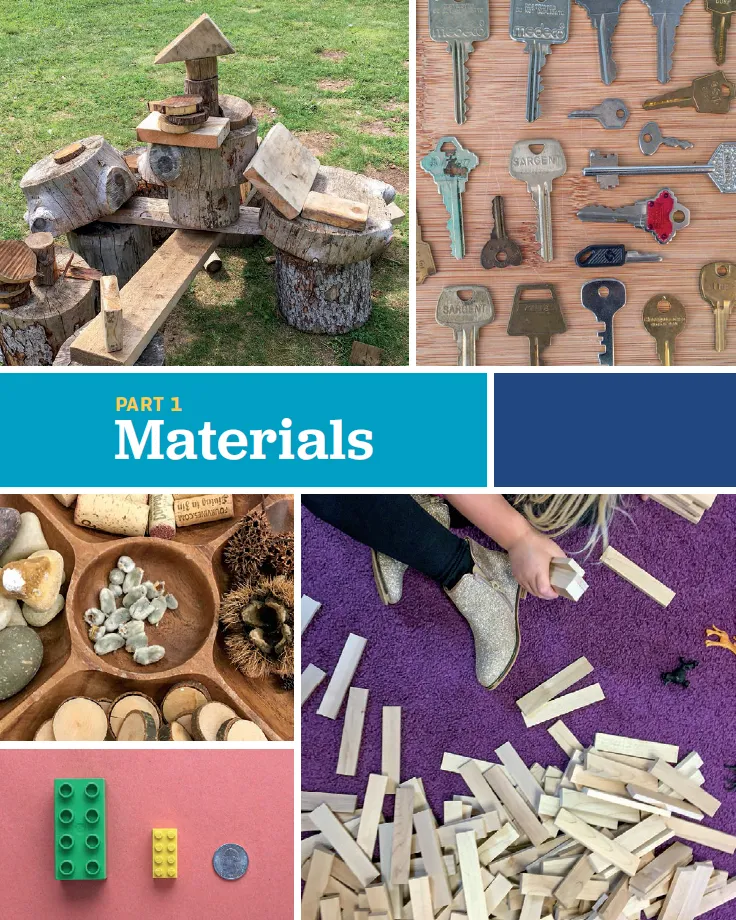
CHAPTER 1
Blocks and Construction Toys
As mentioned in the introduction, construction play is a demonstration of constructivist learning. Piaget and Vygotsky teach us that children construct knowledge through their direct experience with the environment and with other people. Constructivism relates to all kinds of active play, but it is most beautifully relevant to block play. When children build with blocks, they literally construct their knowledge of shape, size, weight, scale, balance, symmetry, gravity, and more.
In terms of learning, block play develops many of the “big ideas” of early math as defined by the Erikson Institute Early Math Collaborative: shape, spatial relationships, patterns, and measurement (Brownell et al. 2014). Block play also demonstrates all five of the characteristics associated with healthy brain development described in the research summary Neuroscience and Learning through Play: A Review of the Evidence, published by the LEGO Foundation (Liu et al. 2017).
In addition, building with blocks is creative expression, a demonstration and practice of architectural design concepts. Frank Lloyd Wright famously noted the relationship between his childhood experiences with blocks and his exceptional career as an architect: “The smooth cardboard triangles and maple-wood blocks were most important. All are in my fingers to this day.… I soon became susceptible to constructive pattern evolving in everything I saw. I learned to ‘see’ this way and when I did, I did not care to draw casual incidentals to Nature. I wanted to design” (Turner 2011).
Let’s take a closer look at how and why block play is an integral part of early childhood education.
The Unit Block
Just as a living organism is made of individual cells, a preschooler’s complex block structure is made of individual blocks. And in early childhood classrooms, the cell of constructivist play is the basic brick, also known as the unit block. It has a standardized shape and size consistent among toy and school supply products.
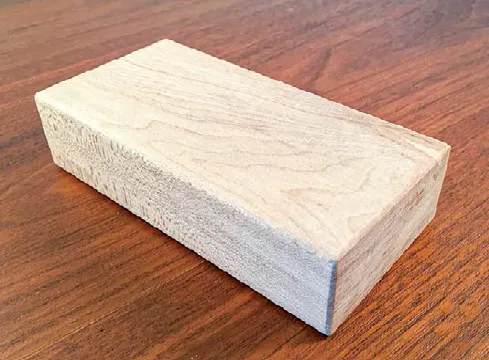
The standard unit block is 5.5 inches long, 2.75 inches wide, and 1.375 inches thick.
The idea that children will benefit from building with uniform blocks stems back to Fröbel, who designed a numbered series of classroom toys called “Gifts.” When examined in order, each Gift is more complex than the previous one.
For example, Gift 1 is a simple ball, a sphere. Gift 2 is a set of three objects with different shapes: a sphere, a cube, and a cylinder. Gift 3 is a set of eight cube blocks, which can be assembled into a larger cube as a tangible lesson in how the whole is the sum of its parts. Gift 4 is a set of eight rectangular prism blocks. Many popular construction toys, such as LEGO, can trace their heritage back to Gift 4.
Inspired by Fröbel’s Gifts, American educator Caroline Pratt designed unit blocks in the early twentieth century. Pratt was both a preschool teacher and a woodworker. She tested many different block proportions and types of wood until she came up with what she believed was the perfect design for construction play. At 5.5 inches long, 2.75 inches wide, and 1.375 inches thick, the unit block has a mathematically beautiful ratio of 1:2:4.
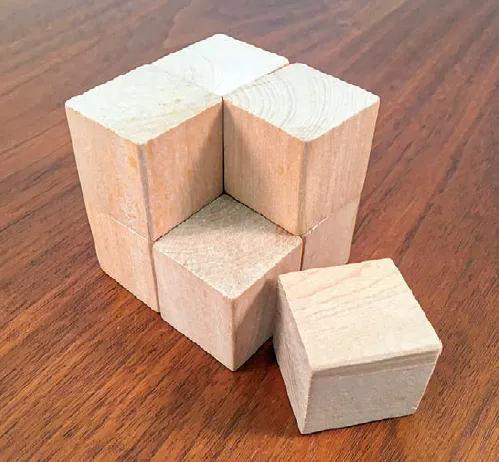
The third Fröbel Gift is a set of eight cube blocks.
Few play materials provide more benefit than wooden blocks. So even if your set of unit blocks is battered and worn, it’s still one of the most valuable treasures in your classroom. In The Design of Childhood: How the Material World Shapes Independent Kids, Alexandra Lange remarks that unit blocks “always seem to be used most quickly, forcing children to assemble more idiosyncratic pieces—the squares, the right triangles—back into satisfying bricks, teaching basic principles of geometry, by the by, the same way Froebel’s cubes-in-a-cube did” (Lange 2018, 31).
The Role of the Brick in Architecture
Building with unit blocks is not just a whimsical or abstract activity for children. Rather, it’s a direct connection to actual construction in the real world. Just as unit blocks are essential to block play, basic bricks are essential to architecture. Take a quick glance around your community and you’ll see how ubiquitous bricks are in the design and construction of buildings.
Masonry is a type of construction that uses stone or concrete bricks, blocks, and tiles. Bricks have a standard size and shape in masonry construction. Like unit blocks, they are rectangular prisms. Mortar, a binding adhesive, is used to hold the bricks together. Bricks are often made of clay, not wood.
The term brickwork is used to describe the patterns and processes used to lay the brick.
Why are bricks so essential? As a teacher, I often ask children, “Would you rather build a house out of unit blocks or cubes? Why?” So I now ask you, my reader, a similar question: “Why is a rectangular prism better for building than a square cube?”
You might begin by commenting that a rectangular prism has elongated planes, or sides. In contrast a cube has square planes with less surface area. This is key. The elongated planes provide more surface to spread mortar. And due to its longer length, a rectangular prism also lends itself better to an alternating pattern than does a cube. Staggering the bricks in their placement creates a much stronger wall than placing them in direct alignment.
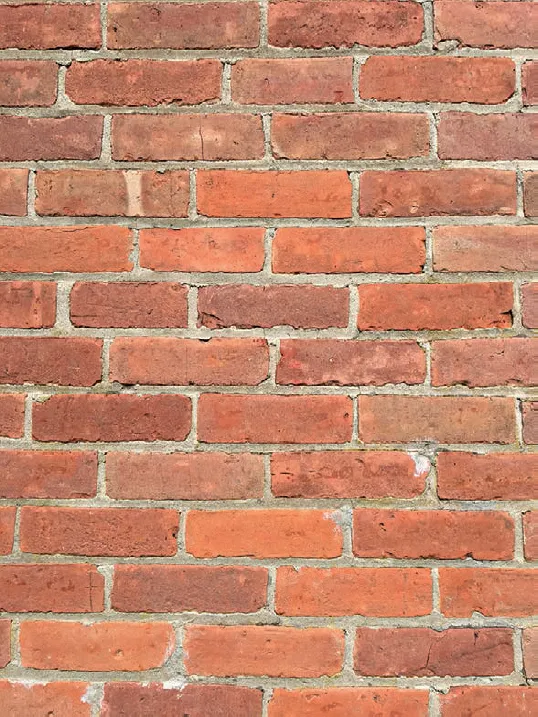
The concept of the brick, a rectangular prism, is important in both architecture and block play.
Other Types of Blocks
Wooden unit blocks are practically perfect for any kind of preschool block play. However, there are certainly other options and block systems to inspire architectural play.
Wooden plank blocks, such as KEVA or KAPLA blocks, share many features with unit blocks. Each plank is a standard and uniform size and weight, though smaller and lighter than unit blocks. Plank blocks can be used on either the floor or a table. Because they are smaller than unit blocks, plank blocks require greater dexterity to manipulate and are better suited for older preschoolers and kindergarteners.

Plank blocks are smaller and lighter than unit blocks.
Cube blocks are less common than rectangular prism blocks. The different shape offers varied opportunities for building. A set of simple wooden cube blocks is reminiscent of the original Fröbel Gifts from the nineteenth century. And yet many children today are drawn to cube blocks, either wooden or foam, because they are inspired by digital games such as Minecrfat. Cubes are the literal building blocks for structures and even characters in these games.
Magnetic tiles and blocks are also popular construction toys. Some brands include Magna-Tiles, PicassoTiles, and Tegu Blocks. Interestingly, building with magnetic toys is both very easy and very difficult for children. It’s easy because the magnets snap the blocks together, keeping them connected without having to worry about balance and symmetry. On the other hand, if the magnets aren’t properly aligned—say, if a positive pole meets another positive pole—the blocks will snap apart or shift their position.
If you have magnetic building toys in your learning environment, it’s important to talk with children about how magnets work. This helps scaffold their understanding so they can learn how to take advantage of the power of the magnets.
For example, if something unexpected or frustrating happens to a child building with magnetic construction toys, turn it into a teachable moment. Begin by asking open-ended questions to gauge what the child already understands about magnets. You might say, “I see the roof of your house snapped apart and fell down. I wonder why that happened. What do you think?”
Perhaps the child will say the word magnet and show some understanding of how magnets work. In that case help her explore, through trial and error, how turning the block around will make a stronger bond.
Or perhaps the child has no experience with, or understanding of, magnets. Then it might be helpful to use a pair of plain horseshoe or bar magnets, with the poles labeled and visible, to show the child how magnets can attract and repel each other. Once a basic concept is in place, you can apply it to how the blocks attract and repel.
LEGO Blocks
LEGO is a very popular block system. Invented in 1932 by Danish toymaker Ole Kirk Cristiansen, LEGO blocks are colorful, come in many sizes and shapes, and are relatively inexpensive.
Also popular is Duplo, LEGO’s chubby cousin. Duplo blocks are recommended for children under age three and for children new to LEGO construction. Because Duplo blocks are larger than LEGO blocks, they are easier to manipulate with little hands, and they don’t pose choking hazards.
Both LEGO and Duplo blocks offer a different experience than wooden blocks. Wooden blocks rest on each other, using only the force of gravity, while LEGO blocks have an interlocking design that firmly snaps together. It’s important to stress, however, that due to this interlocking system, LEGO blocks can’t provide the same level of challenge and creativity as wooden unit blocks. Children develop fine-motor and cognitive skills as they learn to balance and align wooden unit blocks in strong and symmetrical patterns.
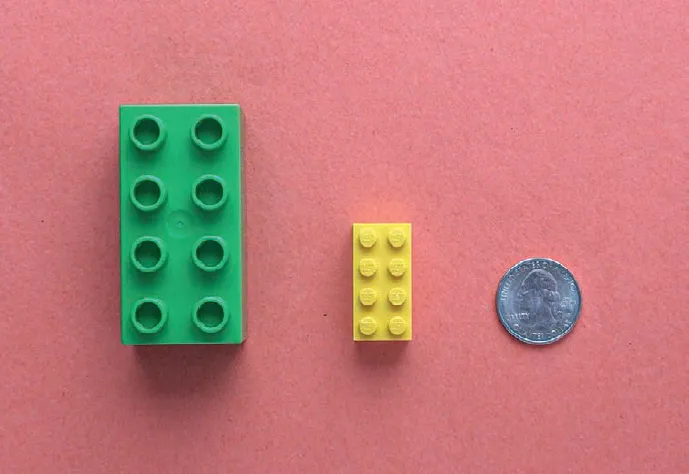
A Duplo brick, shown here in green, is much larger and easier to manipulate than a LEGO brick, shown here in yellow.
As supplemental construction toys, though, LEGO blocks inspire nearly endless creativity for building, design, and construction. Because of their versatility, they are well regarded as a learning and modeling tool among many professional architects.
The LEGO House—a children’s museum and play space in Billund, Denmark—features an interactive exhibit called “6 Bricks Factory.” The exhibit demonstrates how even a small number of classic LEGO bricks can be arranged in many creative ways. In fact, mathematician Søren Eilers has determined that six LEGO bricks can be arranged in 915,103,765 combinations (Higgins 2017).
A Word about Themed LEGO Sets
As a Reggio-inspired educator who values child-centered learning, I feel compelled to clarify that I recommend only Classic LEGO sets as a creative ...
Table of contents
- Cover
- Title Page
- Copyright
- Dedication
- Contents
- Acknowledgments
- Prólogo/Foreword
- Introduction: Why Architecture?
- Part 1. Materials
- Part 2. Explorations
- Recommended Resources
- References